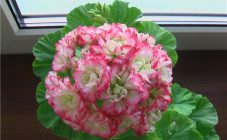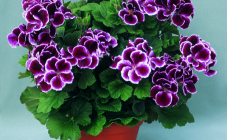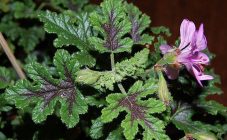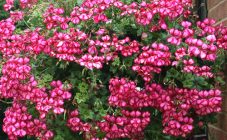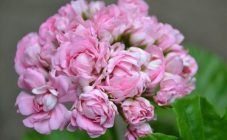Content:
Pelargonium Lara Harmony is by far one of the most popular flowering plants. It is distinguished by its unpretentious care, therefore it often becomes a favorite and is grown on window sills, flower beds, and small areas.
Lara Harmony belongs to the varieties of Terry Pelargonium (geranium). Belongs to the Geranev family, the group is zonal. The appearance is due to small areas on each leaf - usually dark brown in color.
The history of the creation of the variety
The first terry pelargoniums were discovered in the middle of the last millennium on the African continent. The plant was attracted to the discoverers by the color of the flowers and the capsule. Its shape resembled the beak of a stork, which is why the new culture was given the name Pelargoniums (translated from Greek means "stork").
Gardeners owe the appearance of the Lara Harmony variety to the Australian collector - Cliff Blackman. It was he who, in the 2000s, bred the famous varieties with the prefix Lara (denotes the city in Australia where the breeder lived and worked).
Variety characteristics
| Plant parameters | · The stem height varies from 0.3 to 0.5 m. |
|---|---|
| · Erect stem with alternately growing leaves. | |
| · Developed root system. | |
| · Round, palmate (veins diverge in a ray-like manner) leaves of a dark green color with a pronounced red-brown circle. Produces a pleasant mint aroma. | |
| · Stem, leaves are covered with small white fleecy hairs (pubescence). | |
| Inflorescence | · Under normal conditions, pelargonium blooms throughout the spring and summer. If you take care of lighting, then also in the winter, autumn periods. At the same time, the flowers of a plant blooming all year round are medium-sized, faded. |
| · Umbrella-shaped inflorescences. Flowers with 5 petals, lilac-pink, double, with a diameter of 12-16 cm. | |
| · The plant is self-pollinated. | |
| · After flowering, in place of flowers, seed boxes appear, resembling a stork's beak. | |
| Frost resistance | Average. The variety can withstand frosts in the region of -28 degrees Celsius, therefore it is grown in areas with a mild climate and window sills. |
| Drought tolerance | Average. The plant does not tolerate stagnant water and a long lack of moisture in the soil. |
Agrotechnics
Pelargonium Lara Harmony is considered unpretentious in care, but even this variety requires the provision of certain simple rules in cultivation. If they are not followed, the plant does not bloom, looks painful, and later dies.
Soil requirements
Prefers slightly acidic or acidic soils. Under the basis, most often buy universal soil: vermiculite, river sand, perlite. Leafy soil from the site, peat (a mandatory mixture with neutral acidity), turf are added to the soil for abundant fruiting.
If geranium is grown on windowsills, then clay or ceramic pots are taken as a container. If plastic, then only white, so that it does not get too hot in the sun, does not rot.
Reproduction and planting
Pelargonium Lara Harmony propagates in 2 ways: cuttings and seeds.
The first option is a simple procedure:
- Freshly cut cuttings are immediately sent to a container of water to form roots. It is important to maintain a high temperature (25 degrees Celsius) and change the water every 2-3 days.
- When the stalk gives good roots, it is taken out of the container and allowed to dry for 3 hours to allow excess moisture in the glass.
- The sprout is planted in the soil treated with manganese.
- As soon as the first signs of growth appear, pinch off the top of the plant.
If the cuttings are planted in open ground, then the seedlings are prepared in March-April, when possible frosts have passed. Planting is done in mid-April.
The second method is laborious and time consuming.
Most often, experienced gardeners, breeders, who develop new varieties of pelargonium, resort to it:
- Only loose soil with the addition of humus, sand, peat is suitable for growing.
- Planting is carried out in March or earlier, provided there is good lighting. In winter, the plant is illuminated with ultraviolet light.
- The seeds are slightly buried in the ground, without sprinkling them with soil from above.
Care
Geranium requires space and good lighting, so they choose the south side with a small amount of seedlings. The crowded arrangement makes you stretch.
In summer, the plant requires much more moisture than in winter. Watering in the summer is done every 2-3 days as the soil dries up.
In no case should organic fertilizers be used as fertilizers. It is better to use fortifying substances based on nitrogen, phosphorus, potassium. It is necessary to fertilize the plant 2 times: before and after flowering. Pelargonium is abundantly fertilized before feeding.
To form an even bush of pelargonium on the windowsill, it is recommended to rotate the plant once every 2 days.
When and how to replant
Geranium is transplanted with a strong growth of the root system, flooding of the flower, and the absence of flowering. It is advisable to carry out the procedure in the fall, when the plant is at rest.
For the new soil, drainage is prepared, which takes up 1/5 of the soil. Lara Harmony is taken out so as not to damage the root system. Decaying parts are removed with sharp scissors. The plant is transferred to a pot, watered. Then they are removed to a dark place for a week.
Advantages and disadvantages of the variety
Unlike its counterparts, Lara Harmony pelargonium has a number of positive aspects:
- Compact and neat bushes.
- Pink inflorescences of a rich lilac shade.
- Does not require constant feeding.
- Good winter hardiness, frost resistance. Grown in open ground in the summer as an annual flower.
- It can bloom all year round.
But the variety has disadvantages:
- Does not tolerate stagnant water, drought.
- Requires abundant watering, good illumination.
- Loose flowering occurs.
- Large peduncles that often have to be plucked.
Geranium Lara Harmony is a great option for lovers of lush inflorescences. Observing simple rules, you can get a beautiful decoration of a window sill or a plot of a house or summer cottage.





